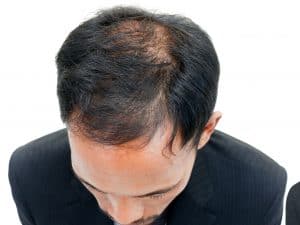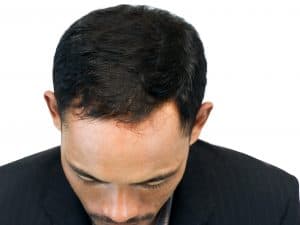Telogen Effluvium Hair Loss
Telogen effluvium hair loss is a phenomenon that occurs after pregnancy, major surgery, drastic weight loss, or extreme stress, in which you shed large amounts of hair every day, usually when shampooing, styling, or brushing. It can also be a side effect of certain medications, such as antidepressants, beta-blockers, and non-steroidal anti-inflammatory drugs. During telogen effluvium, hair shifts faster than normal from its growing phase into the “resting” phase before moving quickly into the shedding, or telogen, phase.
During pregnancy, you may have been thrilled with your thick and lustrous mane of hair. Except for some dryness, you may have thought, wow, pregnancy has finally given my hair some life! But then once you have your baby — poof! You’re alarmed, even shocked, to find that your hair seems to be falling out
It is common for women to notice many different changes to their bodies during pregnancy. While some may notice that their hair seems to grow better while they are pregnant, others worry that they will lose hair during this time. Is pregnancy the culprit to hair loss? Here are some of the things that you should know about how pregnancy may affect your head of hair.
Some hair loss conditions go by the name “effluvium,” which means an outflow. Effluviums characteristically affect different phases of the hair growth cycle.
Hair follicles on the scalp do not continuously produce hair. They cycle through a growth stage that can last two or more years, then regress to a resting stage for up to two months before starting to grow a new hair fiber again. At any time on a healthy human scalp, about 80% to 90% of the hair follicles are growing hair. These active follicles are in what is called the anagen phase. That leaves up to 10% to 20% percent of scalp hair follicles in a resting state called telogen when they don’t produce any hair fiber.
What is Telogen Effluvium Hair Loss?
Telogen effluvium (TE) is probably the second most common form of hair loss dermatologists see. It is a poorly defined condition; very little research has been done to understand TE. In essence, though, TE happens when there is a change in the number of hair follicles growing hair. If the number of hair follicles producing hair drops significantly for any reason during the resting, or telogen phase, there will be a significant increase in dormant, telogen stage hair follicles. The result is shedding or Telogen Effluvium hair loss.
Telogen Effluvium appears as a diffuse thinning of hair on the scalp, which may not be even all over. It can be a bit more severe in some areas of the scalp than others. Most often, the hair on top of the scalp thins more than it does at the sides and back of the scalp. There is usually no hairline recession, except in a few rare chronic cases.
The shed hairs are typically telogen hairs, which can be recognized by a small bulb of keratin on the root end. Whether the keratinized lump is pigmented or unpigmented makes no difference; the hair fibers are still typical telogen hairs.
People with TE never completely lose all their scalp hair, but the hair can be noticeably thin in severe cases. While TE is often limited to the scalp, in more serious cases TE can affect other areas, like the eyebrows or pubic region.
Whatever form of hair loss TE takes, it is fully reversible. The hair follicles are not permanently or irreversibly affected; there are just more hair follicles in a resting state than there should normally be.
There are three basic ways Telogen Effluvium can develop.
1. There might be an environmental insult that “shocks” the growing hair follicles so much that they decide to go into a resting state for a while. This results in an increase in hair shedding and a diffuse thinning of hair on the scalp. This form of TE can develop rapidly and may be noticeable one or two months after receiving the shock. If the trigger is short-lived, then the hair follicles will return to their growing state and start producing new hair fibers pretty quickly. This form of TE usually lasts less than six months and the affected individual has a normal scalp hair density again within a year.
2. The second form of Telogen Effluvium develops more slowly and persists longer. The hair follicles may not all suddenly shed their hair fibers and enter a resting telogen state. Rather, the follicles may enter a resting state as they normally would, but instead of returning to a new anagen hair growing state after a month or two, they stay in their telogen state for a prolonged period.
This results in a gradual accumulation of hair follicles in a telogen state and progressively fewer and fewer anagen hair follicles are left growing hair. In this form of TE, there may not be much noticeable hair shedding, but there will be a slow thinning of the scalp hair. This form of TE is more likely to occur in response to a persistent trigger factor.
3. In the third type of Telogen Effluvium, the hair follicles do not stay resting but rather cycle through truncated growth cycles. When this happens, the individual experiences thin scalp hair and persistent shedding of short, thin hair fibers.


Causes of Telogen Effluvium: Stress and Diet
What are the trigger factors for TE? The short answer is many and varied. Classic short-term TE often happens to women soon after giving birth. Called postpartum alopecia, the sudden change in hormone levels at birth is such a shock to the hair follicles that they shut down for a while. There may be some significant hair shedding, but most women regrow hair quickly.
Similarly, vaccinations, crash dieting, physical trauma such as being in a car crash, and having surgery can sometimes be a shock to the system and a proportion of scalp hair follicles go into hibernation. As the environmental insult passes and the body recovers, the TE subsides and there is new hair growth.
Some drugs may also induce TE, especially antidepressants. Often a switch to a different drug resolves the issue.
More persistent insults can result in more persistent TE. For example, a chronic illness may lead to TE. Arguably, the two most common problems are chronic stress and diet deficiency. Many dermatologists believe chronic stress can gradually exert a negative effect on hair growth and lead to persistent TE. Research with animal models has provided evidence to back up this claim. There does indeed seem to be a link between stress, a change in hair follicle biochemistry, and more hair follicles entering a telogen resting state.
Whether dietary problems are causing TE in North America is hotly argued among dermatologists. A lack of a mineral, vitamin, or essential amino acid can certainly cause TE, such as with people in third world countries where diets can be completely deficient in one or more nutrients. Animal experiments also provide supporting evidence.
In first world countries, the average diet is rarely completely deficient in a particular vitamin or mineral. However, some dermatologists claim that with a reduction in red meat intake and a preference for vegetarian diets, some individuals are not getting a balanced intake of all the nutrients required for good hair and overall body growth. In particular, there are claims that women may be deficient in their iron intake. Why women specifically? Because women lose iron at regular intervals as a result of menstruation.
Some dermatologists believe that as we now eat less red meat, a key source of iron, some people are not eating enough iron and TE is the result. Other potential deficiencies of the modern North American diet — such as a lack of zinc, amino acid L-lysine, or vitamins B6 and B12 — have also been suggested to contribute to TE.
When dietary deficiencies are suspected, supplements may be taken. However, supplements themselves can cause problems. Our bodies can only process so much iron each day. At high doses, iron is toxic and this can itself cause hair loss. At really high doses, iron supplements will cause death. Vitamin A supplements can also cause a TE reaction in some individuals, as excessive vitamin A can also be toxic.
TE can occur on its own or as part of another disease. The early stages of androgenetic alopecia (male or female pattern baldness, AGA for short) are effectively TE. Early AGA is characterized by an increase in resting telogen hair follicles. Someone in the early stages of AGA may have up to 40% of their scalp hair follicles in telogen.
TE can also be a symptom of other conditions, such as inflammatory conditions like alopecia areata. Hair follicles are particularly sensitive to thyroid hormones and about one-third of individuals with a thyroid disorder have TE. Exposure to toxins can also cause TE as one of many symptoms.
What can I do?
Guci Image world leader and innovator in women’s hair loss, has been successfully treating Telogen Effluvian with LASER THERAPY for over a decade. This FDA approved treatment “STOPS” the progression of hair loss in 85% of the patients who undergo treatment, allowing the opportunity to promote new REGROWTH. If you believe your hair loss is more than normal fallout or has continued for an unusual length of time, this can be a sign of something more serious. You should make an appointment with your physician to make sure there is not an underlying problem. For more information on Hair Loss Treatments… Call Guci Image at (201) 734-0051 an receive a Complimentary Consultation and Evaluation.
The right treatment for you
Whether you are you are looking for something Non-surgical or Surgical, we offer a hair restoration solution that fits you.


